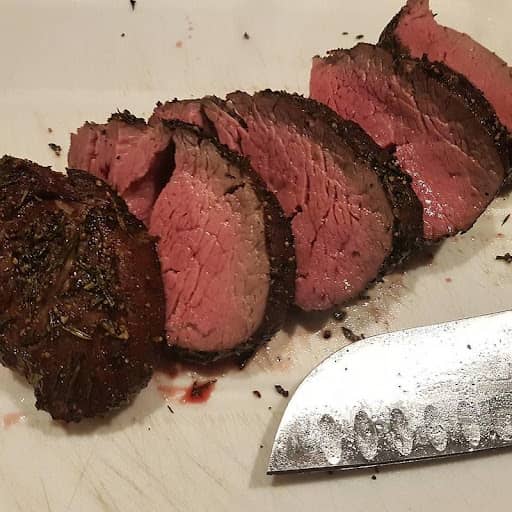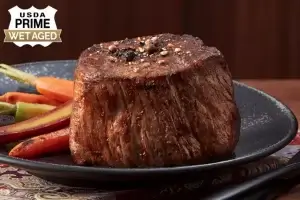
If you cook regularly, you know that cooking different types of meat requires different cooking methods and techniques. You need to understand the basics of temperatures and cooking times, as chicken and steaks, for example, aren’t cooked quite the same.
The same holds true for the many kinds of beef you can cook. Whole beef tenderloin requires a significantly different cooking process than, say, ground beef. If you’re here to learn how to cook whole beef tenderloin the right way, you’ve come to the right place. This guide explains everything you need to know, from choosing the best cut of beef tenderloin to roasting the tenderloin in the oven using popular methods.
Understanding Beef Tenderloin
Beef tenderloin comes from the rear of a cow. More specifically, it’s cut from the sirloin area and extends into the short loin. In fact, the tip of the tenderloin that reaches into the short loin section is what’s better known as filet mignon. There’s only a small portion of filet mignon in each cow, making it one of the most coveted—and expensive—portions of meat you can get from the animal.
Still, beef tenderloin doesn’t have to be filet mignon to be drool-worthy in its own right. In fact, the whole tenderloin is known for its tender texture. This area of the cow isn’t muscular, allowing the meat to have just the right amount of chew while giving it that melt-in-your-mouth texture that’s expected from upscale steaks.
Beef tenderloin isn’t one of the most flavorful cuts of beef you’ll find. That’s actually why it’s preferred for dishes using other ingredients to perk up the flavor profile, like gravy or herb butter. Bacon-wrapped tenderloin is another popular option, with crisp bacon adding just the right amount of flavor to perk up your palate.
When seasoned and cooked correctly, though, beef tenderloin can shine well enough on its own without any extras.
Selecting Quality Beef Tenderloin
If you search for a whole beef tenderloin at the grocery store, you might find a few options to choose from. Butchers can cut beef tenderloin in several ways to get different sizes and different cuts. Although the tenderloin can also be cut into steaks, a whole beef tenderloin is an excellent option for feeding a family.
First, look at the size of the whole beef tenderloin options. An entire beef tenderloin typically weighs between 4-6 pounds. If you don’t need that much, consider looking for a smaller one, like a center-cut tenderloin, that’s usually close to the 2-4 pound range.
Next, look at the meat’s marbling, which is the fat that runs through it. Ideally, you want to see thin white strips throughout the meat rather than thick chunks of fat covering the outside. Marbling is essential for flavoring a tenderloin and preventing it from drying out when cooking.
Finally, look at the label. Is the whole beef tenderloin labeled as USDA Choice or USDA Prime? These labels designate meat that’s passed specific quality standards set by the federal government, helping you choose high-quality cuts. When cooked properly, USDA Prime and USDA Choice beef tend to yield better results than beef without those designations.
Preparation Steps
When you’re ready to learn how to cook a whole beef tenderloin, start with these helpful preparation steps.
Necessary Ingredients and Equipment for Cooking Whole Beef Tenderloin
To cook whole beef tenderloin, you’ll need a roasting pan, a chef’s knife to trim the fat off the meat and slice it afterward, a large skillet, and a meat thermometer. Ideally, your meat thermometer will be an oven-safe one, which you can keep in the meat as it cooks for consistent monitoring. If you’d like to baste your roast as it cooks to help it stay tender, you’ll also need a baster.
As for ingredients, gather olive oil to sear the meat along with your choice of seasonings. Typically, salt and pepper are must-haves, but you can also season whole beef tenderloin with onion powder, garlic powder or minced onion, thyme, your favorite steak seasoning, and other herbs and spices.
Pre-Cooking Preparations and Tips
Before cooking a whole beef tenderloin, it helps to take a few steps to get it ready for the oven.
Start by trimming excess fat off the tenderloin, as thick chunks of fat will have a difficult time breaking down during the cooking process. Use a sharp chef’s knife to remove the fat by lifting up the fat with one hand and gently gliding the blade underneath the fat, as close to the meat as you can.
Next, if your tenderloin is uneven in shape, consider using butcher’s twine to tie it. Fold over the thinner end to double up the tenderloin on that end, and wrap the twine around it to hold it in place. This allows the tenderloin to cook more evenly.
Finally, season the tenderloin with salt along its full length, being sure to flip it over and season the underside as well. Leave the tenderloin salted at room temperature for 30 minutes before cooking.
Searing the Beef Tenderloin
Although this step is optional, we suggest searing a beef tenderloin before putting it in the oven. Searing helps the tenderloin get a lightly crisp crust, which actually allows it to hold in more juices while cooking. The end result? A tender and flavorful tenderloin with just the right amount of external crisp.
Step-by-Step Searing Instructions
After searing the meat, your tenderloin is ready to go directly into the oven to finish cooking, so be sure to have the oven preheating while you follow these steps to sear.
- Preheat a large skillet over medium-high heat with two tablespoons of olive oil.
- Add the tenderloin to the skillet, gently curving the tenderloin so that it fits inside.
- Sear for 5-6 minutes before turning the tenderloin on its other side to sear for another 5-6 minutes.
Oven-Roasting Techniques
It’s now time to cook your tenderloin roast. Here, we explain two methods to cook a whole beef tenderloin.
Fast Oven-Roasting Method
Fast oven-roasting is the process of using higher heat to cook a tenderloin in less time. You might want to use this method if you’re pressed for time or if you prefer your roast with a rarer cook. With this method, the outside of the roast tends to crisp up fast while still leaving some reddish pink in the center. Here’s how to do it:
- Preheat the oven to 450 degrees.
- Sear the tenderloin using the searing instructions outlined above.
- Add the tenderloin to a baking sheet and into the middle oven rack. Cook for about 30 minutes until the internal temperature reaches 100-110 degrees.
- Turn off the oven, but do not open the door. Keep the tenderloin inside the oven for another 15 minutes. The internal temperature of the tenderloin should now be about 120 degrees.
- Broil at 500 degrees for 2-3 minutes.
- Rest for 15 minutes at room temperature before slicing.
Slow Oven-Roasting Method
The slow oven-roasting method is what we suggest using if you have plenty of time to cook your roast and want uniform results. Slow cooking in the oven requires a lower cooking temperature but a longer cooking time, resulting in a juicy, slightly pink center. Even if you like well-done beef, this is the method to use. Follow these steps to slow-roast your tenderloin:
- Preheat the oven to 225 degrees.
- Sear the tenderloin in a large skillet using the searing steps above.
- Place the tenderloin on a baking sheet and move it into the middle of the oven, cooking for 2-4 hours or until a meat thermometer reads 125 degrees.
- Turn the broiler to 500 degrees.
- Move the tenderloin directly under the broiler for 2-3 minutes.
- Rest the tenderloin at room temperature for 15 minutes before slicing and serving.
Temperature and Cooking Time Guidelines
You can play around with the temperatures in each cooking method to find what works best for your oven. The most important numbers to keep in mind are the final internal temperatures for your tenderloin roast. Depending on the level of doneness you prefer, you’ll want to target different internal temperatures when cooking:
- Rare: Remove from the oven when it reaches 115 degrees; the final temperature should reach 120-125 degrees.
- Medium Rare: Remove from the oven when it reaches 125 degrees; the final temperature should reach 130-135 degrees.
- Medium: Remove from the oven when it reaches 135 degrees; the final temperature should reach 140-145 degrees.
- Medium Well: Remove from the oven when it reaches 145 degrees; the final temperature should reach 150-155 degrees.
- Well Done: Remove from the oven when it reaches 155 degrees; the final temperature should reach 160-165 degrees.
Conclusion: Cooking a Whole Beef Tenderloin
Whether you want to fast-roast or slow-roast your whole beef tenderloin, you should get delicious results from following the steps we’ve outlined above. Remember to pay attention to internal temperatures to ensure that you remove the tenderloin from the oven at just the right time to reach your preferred doneness level.
Ready to try cooking a whole beef tenderloin using the tips you’ve learned? Look for quality cuts at your local supermarket or butcher. If you want the convenience of online ordering, consider ordering a heart of rib roast from Chicago Steak Company. This USDA-Prime roast is available wet-aged or dry-aged, giving you 8-9 pounds of quality beef to cook in your own kitchen.


